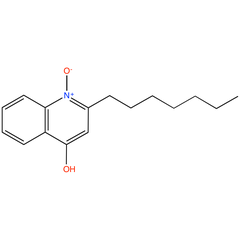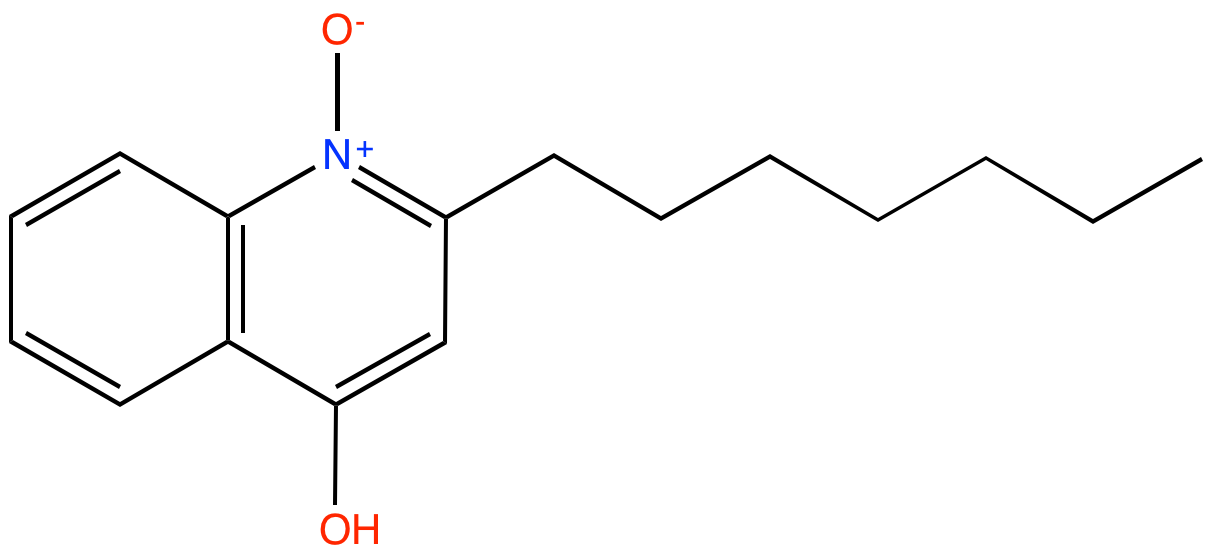
2-Heptyl-4-quinolinol 1-oxide (PAMDB100075)
| Record Information | |||||||||||||||||||||||||||||||||||||||||||||||||||||||||||||||||||||||||
|---|---|---|---|---|---|---|---|---|---|---|---|---|---|---|---|---|---|---|---|---|---|---|---|---|---|---|---|---|---|---|---|---|---|---|---|---|---|---|---|---|---|---|---|---|---|---|---|---|---|---|---|---|---|---|---|---|---|---|---|---|---|---|---|---|---|---|---|---|---|---|---|---|---|
| Version | 1.0 | ||||||||||||||||||||||||||||||||||||||||||||||||||||||||||||||||||||||||
| Update Date | 1/22/2018 11:54:54 AM | ||||||||||||||||||||||||||||||||||||||||||||||||||||||||||||||||||||||||
| Metabolite ID | PAMDB100075 | ||||||||||||||||||||||||||||||||||||||||||||||||||||||||||||||||||||||||
| Identification | |||||||||||||||||||||||||||||||||||||||||||||||||||||||||||||||||||||||||
| Name: | 2-Heptyl-4-quinolinol 1-oxide | ||||||||||||||||||||||||||||||||||||||||||||||||||||||||||||||||||||||||
| Description: | 2-Heptyl-4-quinolinol 1 –oxide (HQNO) is an N-oxide ubiquinone analog that inhibits activity of cytochrome b1 complex, thus inhibiting respiration of Gram-Positive bacteria such as Staphylococcus aureus. HQNO has been shown to induce small colony variants (SCVs) and fermentative metabolism is S. aureus. HQNO is produced from the activity of the PqsL mono-oxygenase protein in Pseudomonas aeruginosa. | ||||||||||||||||||||||||||||||||||||||||||||||||||||||||||||||||||||||||
| Structure | |||||||||||||||||||||||||||||||||||||||||||||||||||||||||||||||||||||||||
| Synonyms: | • 1-Oxyde de 2-heptyl-4-quinoléinol [French] [ACD/IUPAC Name] • 2-Heptyl-4-chinolinol-1-oxid [German] [ACD/IUPAC Name] • 2-Heptyl-4-quinolinol 1-oxide [ACD/IUPAC Name] • 2-Heptylquinolin-4-ol 1-oxide • 341-88-8 [RN] • 4-Quinolinol, 2-heptyl-, 1-oxide [ACD/Index Name] • 1466419 [Beilstein] • 2-(n-heptyl)-4-hydroxyquinoline N-oxide • 2-HEPTYL-4-HYDROXY QUINOLINE N-OXIDE • 2-heptyl-4-hydroxyquinolin-1-ium-1-olate • 2-heptyl-4-hydroxyquinoline N-oxide • 2-Heptyl-4-hydroxyquinoline oxide • 2-Heptyl-4-hydroxyquinoline-1-oxide • 2-Heptyl-4-Hydroxyquinoline-N-Oxide • 2-Heptylquinolin-4-ol, 1-oxide • HOQNO • HQNO • PYO 11 • UNII-1FU5S5CG6A | ||||||||||||||||||||||||||||||||||||||||||||||||||||||||||||||||||||||||
| Chemical Formula: |
C16H21NO2 | ||||||||||||||||||||||||||||||||||||||||||||||||||||||||||||||||||||||||
| Average Molecular Weight: | 259.343 | ||||||||||||||||||||||||||||||||||||||||||||||||||||||||||||||||||||||||
| Monoisotopic Molecular Weight: | 259.157227 | ||||||||||||||||||||||||||||||||||||||||||||||||||||||||||||||||||||||||
| InChI Key: |
NZPACTGCRWDXCJ-UHFFFAOYSA-N | ||||||||||||||||||||||||||||||||||||||||||||||||||||||||||||||||||||||||
| InChI: | InChI=1S/C16H21NO2/c1-2-3-4-5-6-9-13-12-16(18)14-10-7-8-11-15(14)17(13)19/h7-8,10-12,18H,2-6,9H2,1H3 | ||||||||||||||||||||||||||||||||||||||||||||||||||||||||||||||||||||||||
| CAS number: | Not Available | ||||||||||||||||||||||||||||||||||||||||||||||||||||||||||||||||||||||||
| IUPAC Name: | 2-heptyl-4-hydroxyquinolin-1-ium-1-olate | ||||||||||||||||||||||||||||||||||||||||||||||||||||||||||||||||||||||||
| Traditional IUPAC Name: |
hoqno, HQNO | ||||||||||||||||||||||||||||||||||||||||||||||||||||||||||||||||||||||||
| SMILES: | CCCCCCCC1=CC(O)=C2C=CC=CC2=[N+]1[O-] | ||||||||||||||||||||||||||||||||||||||||||||||||||||||||||||||||||||||||
| Chemical Taxonomy | |||||||||||||||||||||||||||||||||||||||||||||||||||||||||||||||||||||||||
| Taxonomy Description | This compound belongs to the class of organic compounds known as 4-hydroxy-2-alkylquinolines. These are organic compounds containing a quinoline moiety with a hydroxyl group attached to the C4 atom, and an alkyl chain attached to the C2 atom. | ||||||||||||||||||||||||||||||||||||||||||||||||||||||||||||||||||||||||
| Kingdom | Organic compounds | ||||||||||||||||||||||||||||||||||||||||||||||||||||||||||||||||||||||||
| Super Class | Organoheterocyclic compounds | ||||||||||||||||||||||||||||||||||||||||||||||||||||||||||||||||||||||||
| Class | Quinolines and derivatives | ||||||||||||||||||||||||||||||||||||||||||||||||||||||||||||||||||||||||
| Sub Class | 4-hydroxy-2-alkylquinolines | ||||||||||||||||||||||||||||||||||||||||||||||||||||||||||||||||||||||||
| Direct Parent | 4-hydroxy-2-alkylquinolines | ||||||||||||||||||||||||||||||||||||||||||||||||||||||||||||||||||||||||
| Alternative Parents | |||||||||||||||||||||||||||||||||||||||||||||||||||||||||||||||||||||||||
| Substituents |
| ||||||||||||||||||||||||||||||||||||||||||||||||||||||||||||||||||||||||
| Molecular Framework | Aromatic heteropolycyclic compounds | ||||||||||||||||||||||||||||||||||||||||||||||||||||||||||||||||||||||||
| External Descriptors |
| ||||||||||||||||||||||||||||||||||||||||||||||||||||||||||||||||||||||||
| Physical Properties | |||||||||||||||||||||||||||||||||||||||||||||||||||||||||||||||||||||||||
| State: |
Solid, off white powder | ||||||||||||||||||||||||||||||||||||||||||||||||||||||||||||||||||||||||
| Charge: | 0 | ||||||||||||||||||||||||||||||||||||||||||||||||||||||||||||||||||||||||
| Melting point: |
Not Available | ||||||||||||||||||||||||||||||||||||||||||||||||||||||||||||||||||||||||
| Experimental Properties: | Not Available | ||||||||||||||||||||||||||||||||||||||||||||||||||||||||||||||||||||||||
| Predicted Properties |
| ||||||||||||||||||||||||||||||||||||||||||||||||||||||||||||||||||||||||
| Biological Properties | |||||||||||||||||||||||||||||||||||||||||||||||||||||||||||||||||||||||||
| Cellular Locations: | Not Available | ||||||||||||||||||||||||||||||||||||||||||||||||||||||||||||||||||||||||
| Reactions: | |||||||||||||||||||||||||||||||||||||||||||||||||||||||||||||||||||||||||
| Pathways: |
| ||||||||||||||||||||||||||||||||||||||||||||||||||||||||||||||||||||||||
| Spectra | |||||||||||||||||||||||||||||||||||||||||||||||||||||||||||||||||||||||||
| Spectra: | Not Available | ||||||||||||||||||||||||||||||||||||||||||||||||||||||||||||||||||||||||
| References | |||||||||||||||||||||||||||||||||||||||||||||||||||||||||||||||||||||||||
| References: |
| ||||||||||||||||||||||||||||||||||||||||||||||||||||||||||||||||||||||||
| Synthesis Reference: | Not Available | ||||||||||||||||||||||||||||||||||||||||||||||||||||||||||||||||||||||||
| Material Safety Data Sheet (MSDS) |
Not Available | ||||||||||||||||||||||||||||||||||||||||||||||||||||||||||||||||||||||||
| Links | |||||||||||||||||||||||||||||||||||||||||||||||||||||||||||||||||||||||||
| External Links: |
| ||||||||||||||||||||||||||||||||||||||||||||||||||||||||||||||||||||||||

